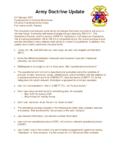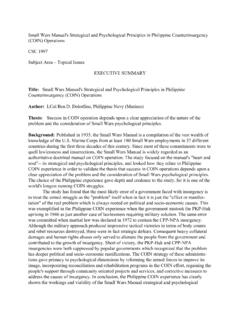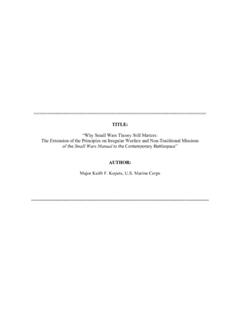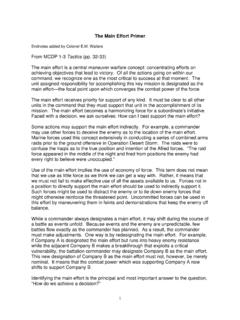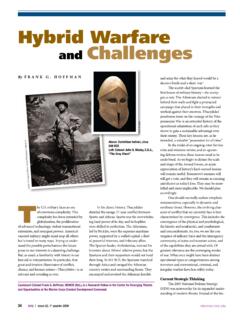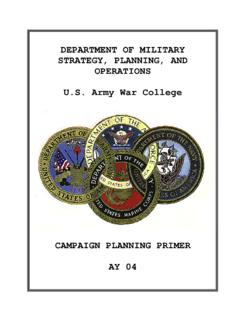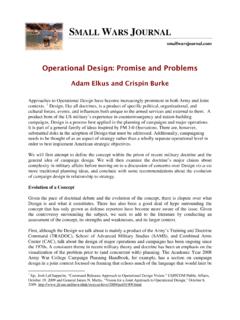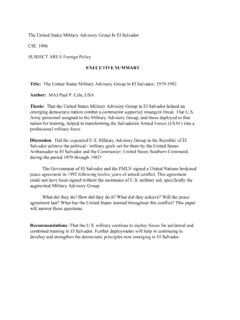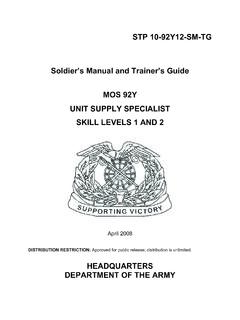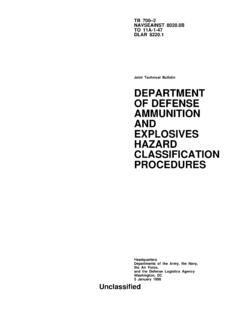Transcription of Lessons Learned, Operation Hue City ... - Small Wars Journal
1 Lessons Learned, Operation Hue city Page--1. Lessons Learned Charlie 1/5, Operation Hue city 31 January 1968 to 5 March 1968. Even under the best of circumstances, street fighting is a bloody business. This was, in the end, the ultimate lesson learned by the United States Marine Corps personnel who participated in this historical battle, considered by many to be the bloodiest of the Vietnam War. The Marine forces involved in Operation Hue city lost 142. Marines killed in action during the month-long battle, including the initial fierce clashes involving, primarily, fighting throughout the southern sections of the city , and the climactic full-scale battles inside the Citadel fortress itself.
2 Hundreds more Marines were wounded and had to be medevacced on both sides of the river. Enemy casualty estimates range well into the thousands. Although Operation Hue city will be long remembered as an overwhelming victory over the best conventional forces the enemy could throw at us, and although the Fifth Marines overcame very unfavorable odds and ultimately triumphed in the finest traditions of Marines in combat, in truth this battle was a very close thing. At the squad, platoon and company levels casualty rates were very severe, as high as 75% or more in some units. Lessons Learned, Operation Hue city Page--2. This was especially true during the first day or two of each unit's initial experience in full scale urban combat.
3 The ultimate success of this Operation could have been significantly improved, in our opinion, by several factors, including: 1. Improved (less restrictive) rules of engagement, including situational flexibility down to the platoon level. 2. Improved communication of intelligence information to all levels of command. 3. Acquisition of improved intelligence data, in particular concerning the disposition and size of enemy forces. Reconnaissance and Small unit probes to fix enemy positions are critical. 4. Improved supporting fire plan. Access to artillery, naval gunfire, direct fire from armored vehicles, and air support should be judiciously deployed.
4 5. Significantly increased training for urban conflict (street fighting). Practice and preparation. 6. Deployment of available chemical weapons (tear gas) for offensive operations during the early stages of the Operation . 7. Improved dissemination of operational plan details, down to the fire team level. On the other side of the scale, Small unit experience, individual Marine determination, the buddy system , the quick Lessons Learned, Operation Hue city Page--3. learning capacity of Marines under combat conditions, the combined leadership (officers, staff NCO's and NCO's) of 1/5 at all levels, and the ultimate ability to coordinate fire support and execute street fighting tactics under heavy fire were the factors that won this pivotal battle, despite incredible odds, high casualty rates and the resulting turnover of officers and NCO's.
5 Certainly, using the 20/20 perspective of hindsight, this battle could have been decided in an even more timely and decisive fashion, reducing friendly casualty rates in the process, by paying attention to the fundamentals of planning Marine operations. Proper prior planning prevents p--- poor performance. * * * * *. The following details regarding the Lessons learned from Operation Hue city are offered from former members of Charlie Company, First Battalion, Fifth Marine Regiment, First Marine Division, who served in combat during Operation Hue city , and who were directly involved in the battle with NVA forces inside the Citadel fortress from 13 February 1968 through 5 March 1968: Situation.
6 Terrain: There is an infinite variety of possible landscapes that may be confronted by a Marine force given the mission of attacking an Lessons Learned, Operation Hue city Page--4. enemy force in urban terrain. When the Tet Offensive broke out on 31 January 1968, and conventional NVA forces overran major sections of the largest cities in South Vietnam, Marine forces were, literally, knee-deep in rice paddies and jungle mud. Since first establishing a beachhead in 1965, Marines had been assigned the mission of conducting a counter-insurgency, a rural conflict, fighting for the most part a guerrilla army. The Tet Offensive changed all of that, and for the first time since the height of the Korean War, in 1954, Marines found themselves with a mission that involved urban combat.
7 Preparing to remove an enemy battalion that has captured a 40-story skyscraper or a college campus is a much different mission than getting an enemy squad out of a house, school or church in a Small town. The common factor in all of these variations, however, is that in all cases, in urban combat structures dominate the terrain. Studying and assessing terrain is a fundamental issue for Marine commanders when planning missions. This is even more critical in planning house-to-house combat operations. Building materials vary worldwide in their ability to provide Small -arms cover to a very high degree. Through use of reconnaissance and intelligence, we recommend conducting a serious assessment of each building or structure that is within your unit's area of operations, because tactics Lessons Learned, Operation Hue city Page--5.
8 Involved in taking each objective (building, structure, etc.) may be different in each case. A Small , wood frame house may offer the illusion of cover from Small arms fire but little else; in some places walls are paper thin. Even houses that use some form of plaster or concrete construction can prove to be unexpectedly porous at the worst possible time. Know the basic layout of a structure, as much as possible, before entry. Approach each structure with an entry plan and a search plan, and make sure each member of each fire team and squad is well-versed in these plans. Establish voice codes and commands, and communicate regularly with each other.
9 Consider entryways (existing doors and windows) to be extremely dangerous, likely locations for booby traps, and to be avoided if at all possible. Wherever possible, blow entry holes using satchel charges or rockets. Once the entry plan is finalized and understood, it must be executed with fierce determination. Be prepared for anything, and be ready to improvise. Be systematic, and check everything (basements, sewer access, attics, rooftops, trash cans) thoroughly before establishing that objective as secure. The other aspect of urban terrain are the spaces between the buildings. Streets, alleys and other pathways are normal routes for humans, and therefore must be suspected to be under Lessons Learned, Operation Hue city Page--6.
10 Observation and possible enemy firing lanes. Whenever possible, take the most difficult route from house to house. Establish, in advance, a plan on what to do in the event non-combatants are found in urban combat zones, and for marking buildings that have been cleared. Make absolutely sure that your Marines are aware that while inside a building being secured, they are at risk from both within and without. Always assume that every room, of every floor, in each and every house, contains enemy soldiers. Always move very quickly when moving in front of windows or doorways. Always know where enemy positions may be in buildings that are adjacent to yours.
